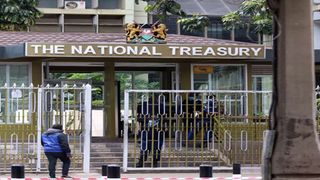
The National Treasury offices.
| Dennis Onsongo | Nation Media GroupCounties
Premium
Asal counties have reaped big from Sh2.4trn in eight years
Turkana County has comparatively been the biggest beneficiary of devolution since its advent eight years ago.
A report on how the national government has disbursed money to counties since devolution began in 2013 shows previously marginalised and sparsely populated counties have gained the most.
The report shows the amounts each county has received every year up to June 2021, the cumulative disbursements and a breakdown of what the payouts would translate to if they were to be divided among residents of respective counties.
Turkana, the biggest beneficiary in relative terms, has received a total of Sh84.7 billion over the eight years.
In the Financial Year (FY) 2013/14, the county received Sh7.6 billion from the National Treasury, which rose to Sh12.6 billion in the FY 2020/21.
If the money the county has received over the period were to be divided among its population, each resident would have been receiving an average of Sh11,432 annually.
“In per capita terms, payments to counties have grown from Sh4,114 in 2013/14 to Sh8,388 in 2020/21. This translates to an annual average of Sh6,404, with Nairobi receiving the least (Sh3,285) and Lamu the highest (Sh18,391),” the National Treasury said in a public statement on the status of payouts to county governments.
Lamu, another historically marginalised county, comes second on the list of the top beneficiaries of devolution in relative terms.
It is closely followed by Tana River, Isiolo, Marsabit and Samburu counties, all of which previously bore the brunt of the centralised system that had been in place from independence in 1963 to 2013, when devolved units were formed.
For instance, even though Lamu County has received the least amount from the national government since 2013, in per capita terms, the county recorded the highest figures.
In 2013/14, Lamu received a total of Sh1.5 billion from the National Treasury, which had more than doubled to Sh3.4 billion by 2020/21, to constitute Sh21.1 billion in cumulative payments over the period.
The county’s payments per person were, however, the highest at an average of Sh18,391 annually.
Tana River, which has received a total of Sh40.1 billion over the eight years, had an annual per capita average of Sh15,885 while Isiolo, with an annual payment per person of Sh14,080, received a total of Sh30.1 billion since 2013.
Most of the counties with high payments per person and low cumulative receipts since devolution came into force fall under the arid and semi-arid lands (Asals).
On the other hand, densely populated counties dominated the list of those that received the highest amounts since the advent of devolution, though the payment-per-person figures were relatively lower – compared to sparsely populated counties.
Nairobi City County leads among these, having cumulatively received Sh115.5 billion since 2013.
The city county received Sh21.1 billion in the FY2020/21, up from Sh9.7 billion in 2013.
Payments per person were, however, the lowest over the period, with a Sh3,285 annual average.
Nakuru County, which has received a total of Sh80 billion over the eight years, also had a lower payments per person annual average at Sh4,629, while Kakamega County, which has received Sh82.9 billion, had an annual average of Sh5,552 per person.
Most of the counties with high cumulative receipts from the national government but low payments per person have huge populations, meaning the resources they receive are relatively lower judging by how much, in monetary terms, each citizen would benefit from them.
Treasury stated that over the eight years, devolved units have received a total of Sh2.4 trillion, 90.6 per cent of which constituted unconditional equitable revenue share, 3.6 per cent conditional grants that are part of shareable revenue and 5.4 per cent additional conditional allocations that are not part of shareable revenue.
A sum of 0.3 per cent of the amount constituted conditional transfers for Covid-19 response in 2019/20, while 0.2 per cent was a one-off payment in 2016/17 to cater for medical personnel allowances and coffee cess.
Treasury reported that the aggregate annual payments to counties grew by Sh203.3 billion, or 103.9 per cent.
“The aggregate payments to county governments in FY2 2020/21 amounted to Sh398.9 billion, which included Sh29.7 billion accruing balances from the allocation for FY 2019/20 and Sh4.6 billion for the Kenya Devolution Support Programme (KDSP) Level 2 programme, which were not part of the County Allocation Revenue Act (CARA), 2020 allocation. The aggregate payments to county governments in FY2020/21 with respect to CARA, 2020 allocation amounted to Sh364.7 billion, which represents 98.6 per cent of CARA, 2020 allocations,” Treasury stated.
However, whether the Sh2.4 trillion disbursed to counties over the eight years has been put to effective use by respective administrations is another matter, especially considering that some counties have been rocked by corruption claims.





